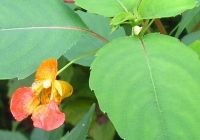Orange Jewelweed (I'll refer to it as Jewelweed) is an annual growing 2-5 feet tall with orange to yellow pouch-like flowers. The leaves are alternate, either egg-shaped or oval, and 1-3 ½ inches long. The leaves are also very soft and smooth to the touch. The stem makes it easy to identify, especially when the flowers aren't present as it is somewhat fragile and succulent or watery in appearance.
The flowers, as mentioned above, range from orange to yellow in color, sometimes almost white (but this is very rare). The flowers are also often spotted which gave rise to another common name, Spotted Touch-me-not. The flowers are ¾-1 ¼ inches long with three petals, one upper petal, and one on each side. The two lateral petals each have a lobe, presumably representing two fused petals. You can find Jewelweed blooming mid-June to mid-September.
The fruit is fleshly green and roughly ¾ inch long. At maturity, the fruit scatters several seeds (mottled green to brown in color) in explosive fashion when touched or shaken.
Pale Jewelweed (Impatiens pallida) can also be found with Orange Jewelweed. While Orange Jewelweed's flowers are typically orange (with a little yellow) and have curved spurs, Pale Jewelweed's flowers are typically all yellow and don't have curved spurs. Pale Jewelweed also can grow in a more mesic habitat where Orange Jewelweed grows usually in a wet habitat. You can find both species in Riverside Park.
 Range/Habitat
Range/Habitat
Jewelweed can be found throughout Wisconsin in swamps, streamsides, ditches, lake shores, marshy areas, thickets, ravines, and wet spots in forests. It can also be found on somewhat disturbed areas including excavations. It also prefers light shade to partial sun.
Wildlife and Ethnobotanical Value
The flowers are adapted to bumblebees, honeybees, and the ruby-throated hummingbirds, and hummingbird moths for pollination, although bees and wasps often bite holes in the spurs to rob the flowers of nectar without pollinating them. Jewelweed has a mucilaginous sap that is supposed to reduce skin irritation caused by poison ivy and stinging nettle. The sap also has fungicidal properties that have been used to treat Athlete's Foot. To use the sap, simply break open the stem of the plant and apply directly on the irritated area.
If you want to learn more about this particular plant or others, feel free to join the land stewardship team at one of our walk-in volunteer times and ask us questions! We are always excited to teach and explore nature together.





